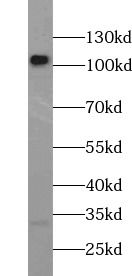Products
NFKB2 antibody
Category:
Research Area:
| Synonyms: | Nuclear factor NF-kappa-B p100 subunit antibody, DNA-binding factor KBF2 antibody, H2TF1 antibody, Lymphocyte translocation chromosome 10 protein antibody, Nuclear factor of kappa light polypeptide gene enhancer in B-cells 2 antibody, Oncogene Lyt-10 antibody, NFKB2 antibody | ||
| Catalogue No.: | FNab05705 | Reactivity: | Human, Mouse, Rat |
| Host: | Rabbit | Tested Application: | ELISA, IHC, WB, IF, IP |
| Clonality: | polyclonal | Isotype: | IgG |
- SPECIFICATIONS
- Product Name
- NFKB2 antibody
- Catalogue No.
- FNab05705
- Size
- 100μg
- Form
- liquid
- Purification
- Immunogen affinity purified
- Purity
- ≥95% as determined by SDS-PAGE
- Clonality
- polyclonal
- Isotype
- IgG
- Storage
- PBS with 0.02% sodium azide and 50% glycerol pH 7.3, -20℃ for 12 months(Avoid repeated freeze / thaw cycles.)
Immunogen
- Immunogen
- nuclear factor of kappa light polypeptide gene enhancer in B-cells 2(p49/p100)
- Alternative Names
- Nuclear factor NF-kappa-B p100 subunit antibody, DNA-binding factor KBF2 antibody, H2TF1 antibody, Lymphocyte translocation chromosome 10 protein antibody, Nuclear factor of kappa light polypeptide gene enhancer in B-cells 2 antibody, Oncogene Lyt-10 antibody, NFKB2 antibody
- UniProt ID
- Q00653
- Observed MW
- 105kd
Application
- Tested Applications
- ELISA, IHC, WB, IF, IP
- Recommended dilution
- WB: 1:200-1:1000; IP: 1:200-1:2000; IHC: 1:20-1:200; IF: 1:10-1:100
Validated Images
 HeLa cells were subjected to SDS PAGE followed by western blot with FNab05705(NFKB2 antibody) at dilution of 1:500
HeLa cells were subjected to SDS PAGE followed by western blot with FNab05705(NFKB2 antibody) at dilution of 1:500
 IP Result of anti-NFKB2 (IP:FNab05705, 4ug; Detection:FNab05705 1:600) with K-562 cells lysate 1200ug.
IP Result of anti-NFKB2 (IP:FNab05705, 4ug; Detection:FNab05705 1:600) with K-562 cells lysate 1200ug.
 Immunohistochemistry of paraffin-embedded human liver cancer tissue slide using FNab05705(NFKB2 Antibody) at dilution of 1:50
Immunohistochemistry of paraffin-embedded human liver cancer tissue slide using FNab05705(NFKB2 Antibody) at dilution of 1:50
 Immunofluorescent analysis of HeLa cells using FNab05705(NFKB2 Antibody) at dilution of 1:25 and Alexa Fluor 488-conjugated AffiniPure Goat Anti-Rabbit IgG(H+L)
Immunofluorescent analysis of HeLa cells using FNab05705(NFKB2 Antibody) at dilution of 1:25 and Alexa Fluor 488-conjugated AffiniPure Goat Anti-Rabbit IgG(H+L)
- Background
- NF-kappa-B is a pleiotropic transcription factor present in almost all cell types and is the endpoint of a series of signal transduction events that are initiated by a vast array of stimuli related to many biological processes such as inflammation, immunity, differentiation, cell growth, tumorigenesis and apoptosis. NF-kappa-B is a homo-or heterodimeric complex formed by the Rel-like domain-containing proteins RELA/p65, RELB, NFKB1/p105, NFKB1/p50, REL and NFKB2/p52. The dimers bind at kappa-B sites in the DNA of their target genes and the individual dimers have distinct preferences for different kappa-B sites that they can bind with distinguishable affinity and specificity. Different dimer combinations act as transcriptional activators or repressors, respectively. NF-kappa-B is controlled by various mechanisms of post-translational modification and subcellular compartmentalization as well as by interactions with other cofactors or corepressors. NF-kappa-B complexes are held in the cytoplasm in an inactive state complexed with members of the NF-kappa-B inhibitor(I-kappa-B) family. In a conventional activation pathway, I-kappa-B is phosphorylated by I-kappa-B kinases(IKKs) in response to different activators, subsequently degraded thus liberating the active NF-kappa-B complex which translocates to the nucleus. In a non-canonical activation pathway, the MAP3K14-activated CHUK/IKKA homodimer phosphorylates NFKB2/p100 associated with RelB, inducing its proteolytic processing to NFKB2/p52 and the formation of NF-kappa-B RelB-p52 complexes. The NF-kappa-B heterodimeric RelB-p52 complex is a transcriptional activator. The NF-kappa-B p52-p52 homodimer is a transcriptional repressor. NFKB2 appears to have dual functions such as cytoplasmic retention of attached NF-kappa-B proteins by p100 and generation of p52 by a cotranslational processing. The proteasome-mediated process ensures the production of both p52 and p100 and preserves their independent function. p52 binds to the kappa-B consensus sequence 5'-GGRNNYYCC-3', located in the enhancer region of genes involved in immune response and acute phase reactions. p52 and p100 are respectively the minor and major form; the processing of p100 being relatively poor. Isoform p49 is a subunit of the NF-kappa-B protein complex, which stimulates the HIV enhancer in synergy with p65. In concert with RELB, regulates the circadian clock by repressing the transcriptional activator activity of the CLOCK-ARNTL/BMAL1 heterodimer.



